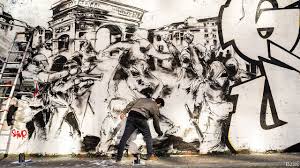Protest art
抗議藝術
Walls have eyes
隔墻有眼
An artist documents clashes between French demonstrators and police
一位藝術家記錄了法國示威者和警察之間的沖突
When Itvan Kebadian spray-painted the words “abolissons la police” above a mural in Paris last year, he was thinking of George Floyd, an African- American whose death under the knee of a white policeman ignited a global movement. But cases closer to home were on his mind, too—of Adama Traore, a young black man who died in custody in France, and Theo Luhaka, who was disabled during a violent arrest, as well as the clashes Mr Kebadian had himself witnessed since he began documenting police brutality in 2016.
當伊特萬·凱巴迪安去年在巴黎的一幅壁畫上噴上“讓我們廢除警察”的字樣時,他想到的是非洲裔美國人喬治·弗洛伊德——遭到白人警察跪殺的弗洛伊德曾引發了一場全球運動。但凱巴迪安同時也想到了幾起本地的案件,年輕的黑人阿達瑪·特拉奧雷在法國被拘留期間死亡、泰奧·盧哈卡在暴力逮捕中致殘、以及他自2016年開始記錄警察暴行以來曾親眼目睹的沖突。
By then Mr Kebadian, who once liked to paint insects, had already turned to political themes. He was finishing a mural when thick black smoke began to rise from a nearby street. A police car had been set on fire; passers-by who had stopped to photograph the painter scurried away as officers moved to confront the culprits.
那時,曾經喜歡畫昆蟲的凱巴迪安先生已經轉向了政治主題。他正在完成一幅壁畫時,附近的一條街上開始冒起濃濃的黑煙。一輛警車被縱火焚燒;停下來給畫家拍照的路人匆匆離去,警察們正準備與罪犯對質。

On impulse, Mr Kebadian painted the unfolding events in simple black lines, a sketch-like method that has become his signature style. His sharp representations of French society have appeared around the capital—and leapt from street walls to those of galleries. “His technique was far superior to that of other street artists,” says Dominique Fiat, who features Mr Kebadian’s work in her gallery.
沖動之下,凱巴迪安先生用簡單的黑色線條描繪了正在展開的事件,這種速寫式的畫法已經成為他標志性的風格。從街道墻壁跳躍到畫廊的墻壁,他對法國社會的鮮明描繪出現在首都的大街小巷。多米尼克·菲亞特說,“凱巴迪安的技術遠遠優于其他街頭藝術家,”她在自己的畫廊展出了凱巴迪安的作品。
“I try to paint reality in reality,” the artist says of his murals. They record clashes between protesters and police, depicting eyes dislodged by rubber bullets, crowds dispersed by clouds of tear gas and telescopic batons breaking jaws. The figures in these tableaux are mostly faceless, composed only of a few lines and shadows. But together they form bleak, eerie scenes of chaos. The results are akin to blurry photos taken hastily with a smartphone; screenshots in paint form, as the artist puts it.
這位藝術家談到他的壁畫時說,“我試圖在現實中描繪現實。”凱巴迪安的壁畫記錄了抗議者和警察之間的沖突,描繪了被橡皮子彈打掉的眼睛,被催淚瓦斯驅散的人群,以及伸縮警棍打傷下巴的場景。這些繪畫作品中的人物大多沒有臉,只有一些線條和陰影。但它們合在一起卻形成了凄涼、怪誕的混亂圖像。效果類似于用智能手機匆匆拍下的模糊照片;正如凱巴迪安所說的繪畫方式截屏。
Christophe Genin, a professor of art at Pantheon-Sorbonne University, links Mr Kebadian’s output to the tradition of protest art that evolved in the 20th century— from the Russian avant-garde of the 1920s to the artistic ferment in America in the 1960s and the political placards that appeared across Paris during the student uprising of May 1968. The murals, notes Mr Genin, also resemble Francisco Goya’s lamentations of war, evincing the same sense of despair as “The Third of May 1808”, in which Goya shows Napoleonic soldiers massacring Spaniards during the Peninsular war. He calls Mr Kebadian an “artivist”.
克里斯托夫·杰寧是巴黎大學的藝術教授,他將凱巴迪安的作品與20世紀演變形成的傳統抗議藝術聯系起來——從20世紀20年代的俄羅斯先鋒派藝術到20世紀60年代美國的藝術熱潮,以及1968年5月學生起義期間出現在巴黎各地的政治標語牌。杰寧教授指出,這些壁畫也類似于弗朗西斯科·戈雅的戰爭哀歌,表現出與《1808年5月3日》相同的絕望感,戈雅在這幅畫中描繪了拿破侖士兵在半島戰爭期間屠殺西班牙人。杰寧教授稱凱巴迪安為“藝術主義者”。
譯文由可可原創,僅供學習交流使用,未經許可請勿轉載。











